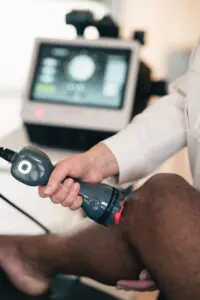High-Intensity Laser Therapy vs Red Light Therapy: What’s the Difference?
The terms high-intensity laser therapy, red light therapy, and photobiomodulation are sometimes used interchangeably—but they aren’t the same. While both red and near-infrared light are used to stimulate the body’s natural healing response, the delivery systems vary greatly in power, precision, and penetration depth.
In this article, we’ll explore the key differences between laser-based photobiomodulation therapy (PBMT) and LED-based red light therapy (RLT)—and why one may be more effective for deeper, targeted applications.
Photobiomodulation vs Red Light Therapy: What’s the Difference?
Photobiomodulation therapy (PBMT) is a broad term referring to the therapeutic use of red or near-infrared light to stimulate cellular function and tissue repair. Both high-powered lasers and low-powered LEDs fall under this category.
However, there are important distinctions within PBMT:
- Red light therapy (RLT) uses low-power LEDs that emit non-coherent light and are typically limited to surface-level applications like skincare or general wellness.
- High-intensity laser therapy, such as that delivered by LightForce systems, uses powerful, near-infrared laser light to target deep tissues with clinical precision and consistent outcomes.
So, while both are technically PBMT, laser therapy represents a more advanced and clinically capable subset of the category.
![]()
Here’s What You Really Need to Know
High-intensity laser therapy (PBMT) uses targeted near-infrared laser light to deliver therapeutic energy deep into soft tissues, joints, and muscles. In contrast, red light therapy (RLT) typically uses low-powered LEDs that produce broader, more superficial effects.
Laser therapy is widely used in clinical settings to support musculoskeletal conditions, while red light therapy is more commonly found in wellness centers and at-home devices.
What Is Photobiomodulation?
Photobiomodulation is a therapeutic approach that uses specific wavelengths of light to influence cellular activity, promote circulation, and support the body’s natural recovery processes. It is commonly delivered using Class IV medical lasers, like those developed by LightForce.
PBMT is also referred to as:
- Low-Level Laser Therapy (LLLT)
- Laser Light Therapy
- Cold Laser Therapy (historical term)
LightForce devices use near-infrared wavelengths (810–980nm), which can penetrate deeply—up to several centimeters—into soft tissue. This makes them ideal for applications involving pain, inflammation, and mobility concerns.
What Is Red Light Therapy?
Red light therapy is a lower-powered form of PBMT that uses LEDs to emit light in the red (630–660nm) and near-infrared (up to 850nm) spectrum. These treatments are generally non-invasive and commonly marketed for cosmetic or wellness purposes.
While RLT can offer temporary benefits such as mood improvement or skin tone enhancement, it lacks the power and tissue penetration necessary to impact deeper musculoskeletal structures. It is not designed for clinical use or complex injury recovery.

PBMT vs RLT: Quick Summary
| Feature | High-Intensity Laser Therapy (PBMT) | Red Light Therapy (RLT) |
| Light Source | High-power Class IV laser | Low-power LED |
| Penetration Depth | Up to 5–6 cm | 0.5–2 cm |
| Clinical Use | Medical and rehabilitation settings | Home, spa, wellness |
| Power Output | 1,000–15,000 mW | 50–500 mW |
| FDA Clearance | Yes – cleared for medical use | Often cosmetic or OTC devices |
| Primary Purpose | Pain relief, injury recovery | Skin, mood, general wellness |
| Treatment Duration | 5–15 minutes | 10–30+ minutes |
| Results Timeline | Often noticeable after 1–3 sessions | May take weeks |
Why Laser Therapy Is Better for Deep Tissue Conditions
While both therapies use light to stimulate biological responses, laser therapy offers several clinical advantages:
- Reaches deeper into soft tissue, joints, and muscle
- Provides a controlled and concentrated dose of energy
- Produces measurable, consistent outcomes in fewer sessions
- Reduces pain and stiffness by influencing cells at a mitochondrial level
This is why high-intensity laser therapy is commonly used in:
- Sports medicine and performance recovery
- Arthritis and joint discomfort
- Acute and chronic soft tissue support
Clinical Applications of PBMT vs Red Light Therapy
| Condition | PBMT | RLT |
| Chronic Pain | Yes | Limited |
| Soft Tissue Injury | Yes | Not effective |
| Joint Stiffness | Yes | Mild support |
| Post-Workout Recovery | Yes | Surface-level |
| Skin Appearance | Not primary | Yes |
Why Choose LightForce for Laser-Based PBMT?
At LightForce, we specialize in near-infrared, laser-powered photobiomodulation—the kind backed by science and trusted by professionals. Our Class IV medical lasers are used by:
- Elite athletic trainers and professional sports teams
- Physical therapists and chiropractors
- Pain management physicians and rehabilitation clinics
Our systems are designed to deliver consistent energy, precise dosing, and deep-tissue results that outperform low-powered devices.
Learn more about Photobiomodulation Therapy
Related Blog
Top Benefits of Photobiomodulation Therapy for Chronic Pain Relief
Take the Next Step Toward Real Relief
If you’re looking for results beyond what over-the-counter wellness tools can offer, it’s time to explore the advantages of high-intensity laser therapy with LightForce.
Schedule a demonstration with your local territory manager today.
Comments
on High-Intensity Laser Therapy vs Red Light Therapy: What’s the Difference?My sister has issues with her neck. She can not straighten it. It lays over to one side and she...

My sister has issues with her neck. She can not straighten it. It lays over to one side and she is in constant pain. Will laser therapy help her and if so which device would you recommend ?